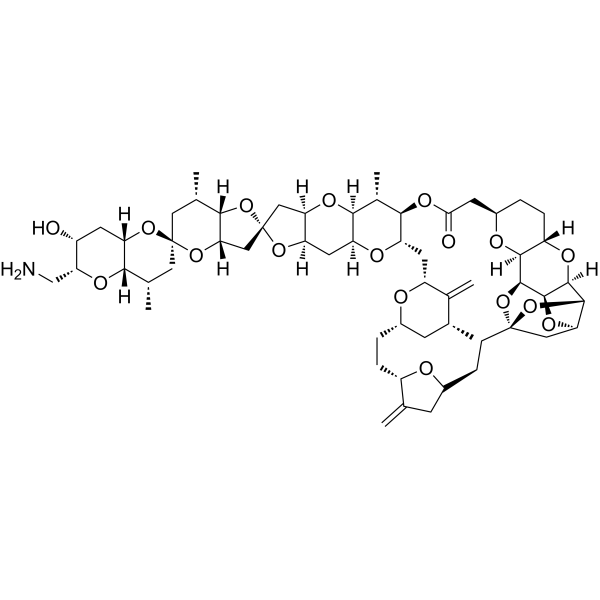Physicochemical Properties
| Molecular Formula | C58H83NO17 |
| Molecular Weight | 1066.28 |
| Appearance | Typically exists as solid at room temperature |
| HS Tariff Code | 2934.99.9001 |
| Storage |
Powder-20°C 3 years 4°C 2 years In solvent -80°C 6 months -20°C 1 month |
| Shipping Condition | Room temperature (This product is stable at ambient temperature for a few days during ordinary shipping and time spent in Customs) |
Biological Activity
| ln Vitro | E7130 inhibits microtubule dynamics and shows antiproliferative activity in cancer cells KPL-4, OSC-19, FaDu and HSC-2 with IC50 values of 0.01-0.1 nM, respectively[1]. E7130 (0.15 nM) inhibits TGF-β-induced myofibroblast transformation by disrupting the formation of microtubule network and inactivating PI3K/AKT/mTOR pathway[1]. |
| ln Vivo | E7130 (45-180 μg/kg, i.v.) increases intratumoral microvessel density (MVD), thereby enhancing cetuximab (CTX) delivery to tumors, leading to tumor regression in HSC-2 SCCHN xenograft BALB/c mice[1]. E7130 (45-180 μg/kg, i.v.) reduces α-SMA-positive CAFs, and the E7130-CTX combination modulates the phenotype of fibroblasts in FaDu SCCHN xenograft BALB/c mice[1]. |
| Cell Assay |
Immunofluorescence[1] Cell Types: BJ cells Tested Concentrations: 0.15 nM Incubation Duration: 48 h Experimental Results: Inhibited TGF-β-induced α-SMA expression in BJ cells without growth inhibitory activity. Western Blot Analysis[1] Cell Types: BJ cells Tested Concentrations: 0.15 nM Incubation Duration: 48 h Experimental Results: Decreased levels of pAKT and pS6. |
| Animal Protocol |
Animal/Disease Models: FaDu SCCHN xenograft BALB/c mice[1] Doses: 45-180 μg/kg Route of Administration: i.v. Experimental Results: Reduced the α-SMA-positive CAFs, modulated the phenotypes of the fibroblasts with combination of CTX. Animal/Disease Models: HSC-2 SCCHN xenograft BALB/c mice[1] Doses: 90 μg/kg Route of Administration: i.v. Experimental Results: Increased MVD, inhibited tumor growth. Increased survival rate with combination of CTX. |
| References |
[1].A landmark in drug discovery based on complex natural product synthesis. Sci Rep. 2019 Jun 17;9(1):8656. |
Solubility Data
| Solubility (In Vitro) | Typically soluble in DMSO (e.g. 10 mM) |
| Solubility (In Vivo) |
Note: Listed below are some common formulations that may be used to formulate products with low water solubility (e.g. < 1 mg/mL), you may test these formulations using a minute amount of products to avoid loss of samples. Injection Formulations (e.g. IP/IV/IM/SC) Injection Formulation 1: DMSO : Tween 80: Saline = 10 : 5 : 85 (i.e. 100 μL DMSO stock solution → 50 μL Tween 80 → 850 μL Saline) *Preparation of saline: Dissolve 0.9 g of sodium chloride in 100 mL ddH ₂ O to obtain a clear solution. Injection Formulation 2: DMSO : PEG300 :Tween 80 : Saline = 10 : 40 : 5 : 45 (i.e. 100 μL DMSO → 400 μLPEG300 → 50 μL Tween 80 → 450 μL Saline) Injection Formulation 3: DMSO : Corn oil = 10 : 90 (i.e. 100 μL DMSO → 900 μL Corn oil) Example: Take the Injection Formulation 3 (DMSO : Corn oil = 10 : 90) as an example, if 1 mL of 2.5 mg/mL working solution is to be prepared, you can take 100 μL 25 mg/mL DMSO stock solution and add to 900 μL corn oil, mix well to obtain a clear or suspension solution (2.5 mg/mL, ready for use in animals). Injection Formulation 4: DMSO : 20% SBE-β-CD in saline = 10 : 90 [i.e. 100 μL DMSO → 900 μL (20% SBE-β-CD in saline)] *Preparation of 20% SBE-β-CD in Saline (4°C,1 week): Dissolve 2 g SBE-β-CD in 10 mL saline to obtain a clear solution. Injection Formulation 5: 2-Hydroxypropyl-β-cyclodextrin : Saline = 50 : 50 (i.e. 500 μL 2-Hydroxypropyl-β-cyclodextrin → 500 μL Saline) Injection Formulation 6: DMSO : PEG300 : castor oil : Saline = 5 : 10 : 20 : 65 (i.e. 50 μL DMSO → 100 μLPEG300 → 200 μL castor oil → 650 μL Saline) Injection Formulation 7: Ethanol : Cremophor : Saline = 10: 10 : 80 (i.e. 100 μL Ethanol → 100 μL Cremophor → 800 μL Saline) Injection Formulation 8: Dissolve in Cremophor/Ethanol (50 : 50), then diluted by Saline Injection Formulation 9: EtOH : Corn oil = 10 : 90 (i.e. 100 μL EtOH → 900 μL Corn oil) Injection Formulation 10: EtOH : PEG300:Tween 80 : Saline = 10 : 40 : 5 : 45 (i.e. 100 μL EtOH → 400 μLPEG300 → 50 μL Tween 80 → 450 μL Saline) Oral Formulations Oral Formulation 1: Suspend in 0.5% CMC Na (carboxymethylcellulose sodium) Oral Formulation 2: Suspend in 0.5% Carboxymethyl cellulose Example: Take the Oral Formulation 1 (Suspend in 0.5% CMC Na) as an example, if 100 mL of 2.5 mg/mL working solution is to be prepared, you can first prepare 0.5% CMC Na solution by measuring 0.5 g CMC Na and dissolve it in 100 mL ddH2O to obtain a clear solution; then add 250 mg of the product to 100 mL 0.5% CMC Na solution, to make the suspension solution (2.5 mg/mL, ready for use in animals). Oral Formulation 3: Dissolved in PEG400 Oral Formulation 4: Suspend in 0.2% Carboxymethyl cellulose Oral Formulation 5: Dissolve in 0.25% Tween 80 and 0.5% Carboxymethyl cellulose Oral Formulation 6: Mixing with food powders Note: Please be aware that the above formulations are for reference only. InvivoChem strongly recommends customers to read literature methods/protocols carefully before determining which formulation you should use for in vivo studies, as different compounds have different solubility properties and have to be formulated differently. (Please use freshly prepared in vivo formulations for optimal results.) |
| Preparing Stock Solutions | 1 mg | 5 mg | 10 mg | |
| 1 mM | 0.9378 mL | 4.6892 mL | 9.3784 mL | |
| 5 mM | 0.1876 mL | 0.9378 mL | 1.8757 mL | |
| 10 mM | 0.0938 mL | 0.4689 mL | 0.9378 mL |
